The Current Management of HIV and Hepatitis: An Essay
VerifiedAdded on 2023/04/25
|27
|8712
|266
Essay
AI Summary
This essay provides a comprehensive overview of HIV and Hepatitis, focusing on their impact on the immune system and disease progression. It delves into the care and management of individuals affected by these conditions, including pharmacological treatments like antiretroviral therapy and direct-acting antivirals. The essay also examines health promotion and prevention strategies, as well as the significant effects of stigma and prejudice on affected individuals. Furthermore, it analyzes the role of the multidisciplinary team in providing care and addresses relevant professional, ethical, and legal issues. The essay highlights the stages of HIV infection, the immune responses to hepatitis, and the various comorbidities associated with both diseases. It emphasizes the importance of early diagnosis, treatment, and support services for individuals and their families, while also acknowledging the societal and economic burdens associated with HIV and Hepatitis.

Running head: ESSAY ON HIV AND HEPATITIS
ESSAY ON HIV AND HEPATITIS
Name of the Student
Name of the University
Author’s Note:
ESSAY ON HIV AND HEPATITIS
Name of the Student
Name of the University
Author’s Note:
Paraphrase This Document
Need a fresh take? Get an instant paraphrase of this document with our AI Paraphraser
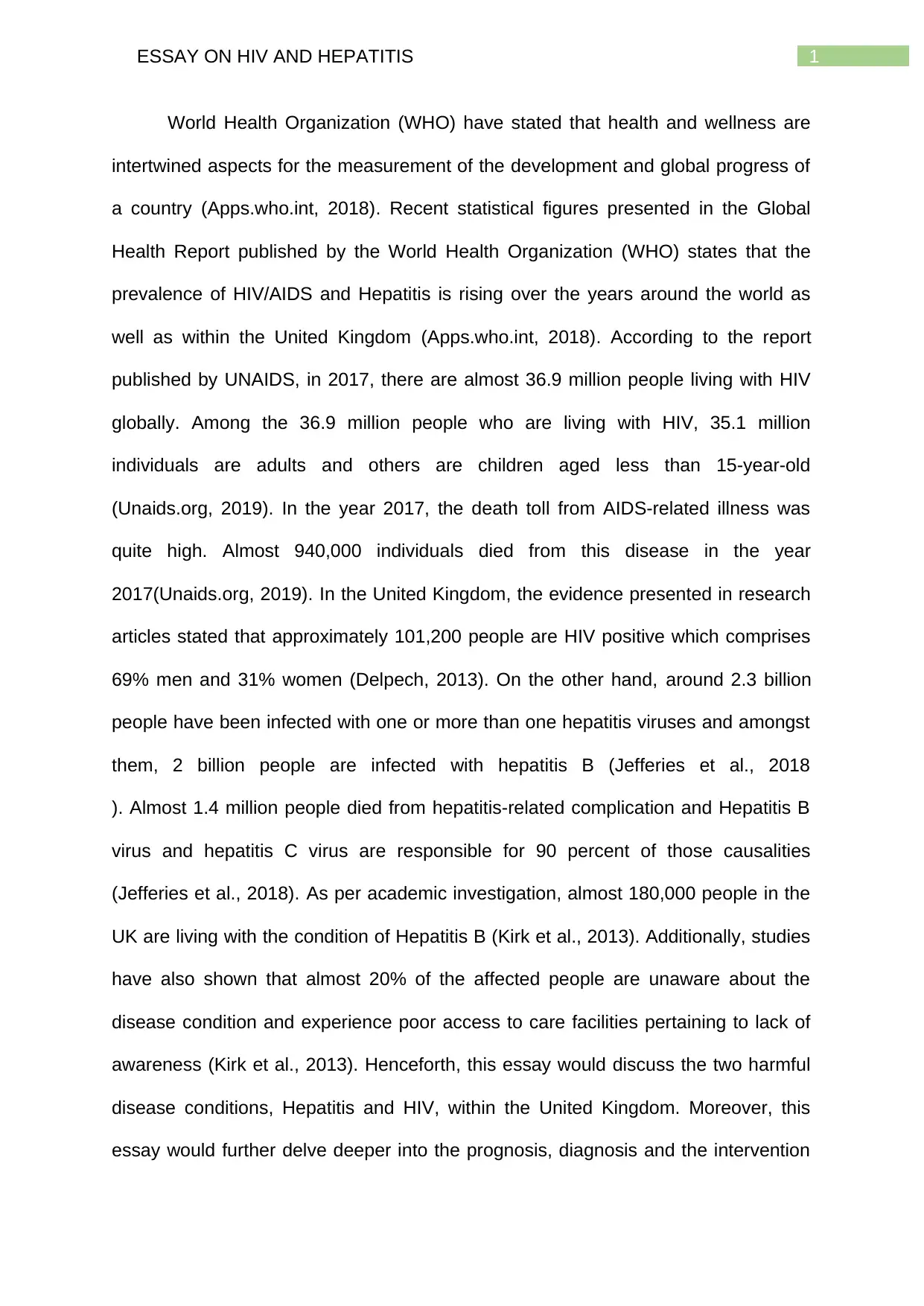
1ESSAY ON HIV AND HEPATITIS
World Health Organization (WHO) have stated that health and wellness are
intertwined aspects for the measurement of the development and global progress of
a country (Apps.who.int, 2018). Recent statistical figures presented in the Global
Health Report published by the World Health Organization (WHO) states that the
prevalence of HIV/AIDS and Hepatitis is rising over the years around the world as
well as within the United Kingdom (Apps.who.int, 2018). According to the report
published by UNAIDS, in 2017, there are almost 36.9 million people living with HIV
globally. Among the 36.9 million people who are living with HIV, 35.1 million
individuals are adults and others are children aged less than 15-year-old
(Unaids.org, 2019). In the year 2017, the death toll from AIDS-related illness was
quite high. Almost 940,000 individuals died from this disease in the year
2017(Unaids.org, 2019). In the United Kingdom, the evidence presented in research
articles stated that approximately 101,200 people are HIV positive which comprises
69% men and 31% women (Delpech, 2013). On the other hand, around 2.3 billion
people have been infected with one or more than one hepatitis viruses and amongst
them, 2 billion people are infected with hepatitis B (Jefferies et al., 2018
). Almost 1.4 million people died from hepatitis-related complication and Hepatitis B
virus and hepatitis C virus are responsible for 90 percent of those causalities
(Jefferies et al., 2018). As per academic investigation, almost 180,000 people in the
UK are living with the condition of Hepatitis B (Kirk et al., 2013). Additionally, studies
have also shown that almost 20% of the affected people are unaware about the
disease condition and experience poor access to care facilities pertaining to lack of
awareness (Kirk et al., 2013). Henceforth, this essay would discuss the two harmful
disease conditions, Hepatitis and HIV, within the United Kingdom. Moreover, this
essay would further delve deeper into the prognosis, diagnosis and the intervention
World Health Organization (WHO) have stated that health and wellness are
intertwined aspects for the measurement of the development and global progress of
a country (Apps.who.int, 2018). Recent statistical figures presented in the Global
Health Report published by the World Health Organization (WHO) states that the
prevalence of HIV/AIDS and Hepatitis is rising over the years around the world as
well as within the United Kingdom (Apps.who.int, 2018). According to the report
published by UNAIDS, in 2017, there are almost 36.9 million people living with HIV
globally. Among the 36.9 million people who are living with HIV, 35.1 million
individuals are adults and others are children aged less than 15-year-old
(Unaids.org, 2019). In the year 2017, the death toll from AIDS-related illness was
quite high. Almost 940,000 individuals died from this disease in the year
2017(Unaids.org, 2019). In the United Kingdom, the evidence presented in research
articles stated that approximately 101,200 people are HIV positive which comprises
69% men and 31% women (Delpech, 2013). On the other hand, around 2.3 billion
people have been infected with one or more than one hepatitis viruses and amongst
them, 2 billion people are infected with hepatitis B (Jefferies et al., 2018
). Almost 1.4 million people died from hepatitis-related complication and Hepatitis B
virus and hepatitis C virus are responsible for 90 percent of those causalities
(Jefferies et al., 2018). As per academic investigation, almost 180,000 people in the
UK are living with the condition of Hepatitis B (Kirk et al., 2013). Additionally, studies
have also shown that almost 20% of the affected people are unaware about the
disease condition and experience poor access to care facilities pertaining to lack of
awareness (Kirk et al., 2013). Henceforth, this essay would discuss the two harmful
disease conditions, Hepatitis and HIV, within the United Kingdom. Moreover, this
essay would further delve deeper into the prognosis, diagnosis and the intervention
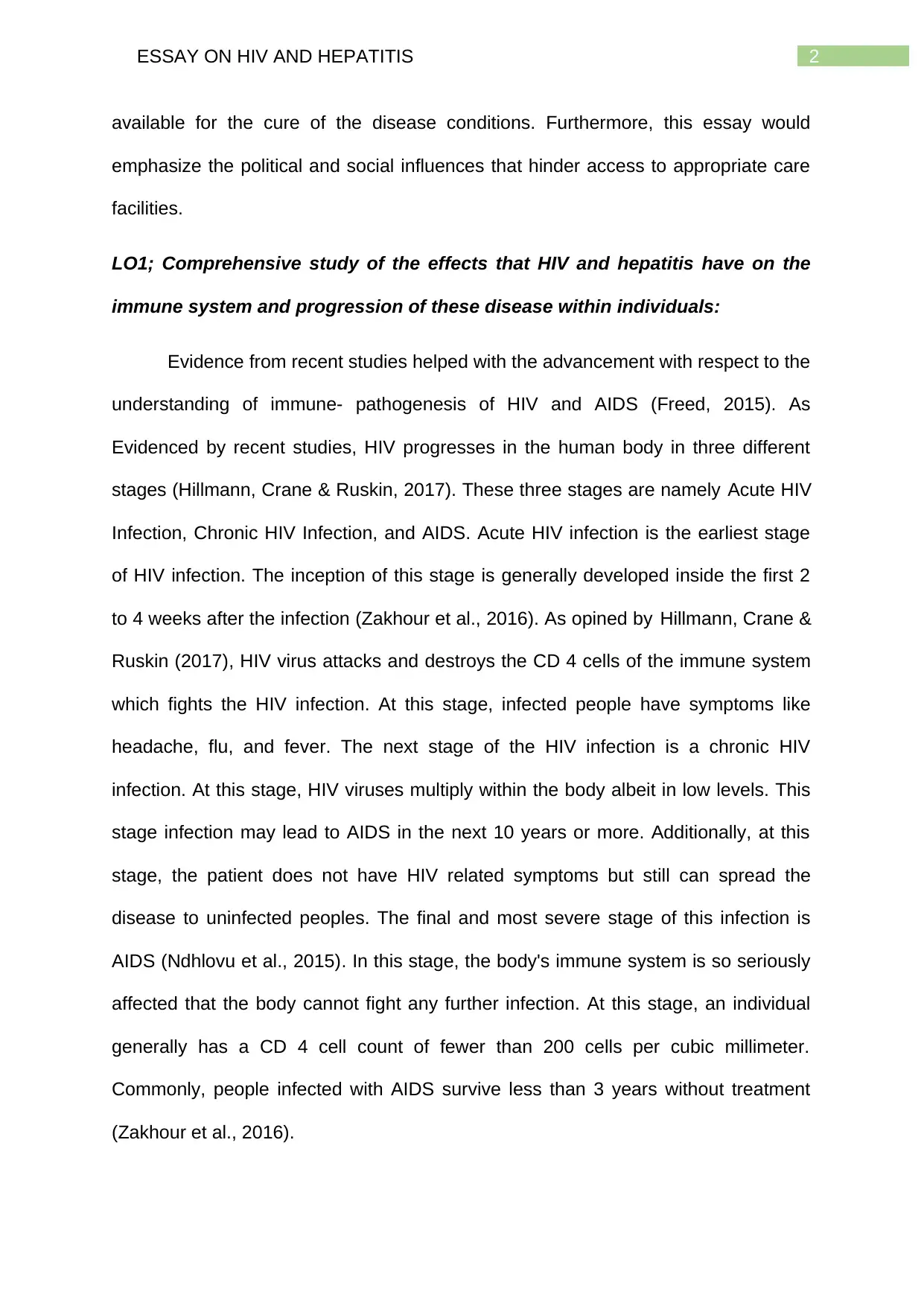
2ESSAY ON HIV AND HEPATITIS
available for the cure of the disease conditions. Furthermore, this essay would
emphasize the political and social influences that hinder access to appropriate care
facilities.
LO1; Comprehensive study of the effects that HIV and hepatitis have on the
immune system and progression of these disease within individuals:
Evidence from recent studies helped with the advancement with respect to the
understanding of immune- pathogenesis of HIV and AIDS (Freed, 2015). As
Evidenced by recent studies, HIV progresses in the human body in three different
stages (Hillmann, Crane & Ruskin, 2017). These three stages are namely Acute HIV
Infection, Chronic HIV Infection, and AIDS. Acute HIV infection is the earliest stage
of HIV infection. The inception of this stage is generally developed inside the first 2
to 4 weeks after the infection (Zakhour et al., 2016). As opined by Hillmann, Crane &
Ruskin (2017), HIV virus attacks and destroys the CD 4 cells of the immune system
which fights the HIV infection. At this stage, infected people have symptoms like
headache, flu, and fever. The next stage of the HIV infection is a chronic HIV
infection. At this stage, HIV viruses multiply within the body albeit in low levels. This
stage infection may lead to AIDS in the next 10 years or more. Additionally, at this
stage, the patient does not have HIV related symptoms but still can spread the
disease to uninfected peoples. The final and most severe stage of this infection is
AIDS (Ndhlovu et al., 2015). In this stage, the body's immune system is so seriously
affected that the body cannot fight any further infection. At this stage, an individual
generally has a CD 4 cell count of fewer than 200 cells per cubic millimeter.
Commonly, people infected with AIDS survive less than 3 years without treatment
(Zakhour et al., 2016).
available for the cure of the disease conditions. Furthermore, this essay would
emphasize the political and social influences that hinder access to appropriate care
facilities.
LO1; Comprehensive study of the effects that HIV and hepatitis have on the
immune system and progression of these disease within individuals:
Evidence from recent studies helped with the advancement with respect to the
understanding of immune- pathogenesis of HIV and AIDS (Freed, 2015). As
Evidenced by recent studies, HIV progresses in the human body in three different
stages (Hillmann, Crane & Ruskin, 2017). These three stages are namely Acute HIV
Infection, Chronic HIV Infection, and AIDS. Acute HIV infection is the earliest stage
of HIV infection. The inception of this stage is generally developed inside the first 2
to 4 weeks after the infection (Zakhour et al., 2016). As opined by Hillmann, Crane &
Ruskin (2017), HIV virus attacks and destroys the CD 4 cells of the immune system
which fights the HIV infection. At this stage, infected people have symptoms like
headache, flu, and fever. The next stage of the HIV infection is a chronic HIV
infection. At this stage, HIV viruses multiply within the body albeit in low levels. This
stage infection may lead to AIDS in the next 10 years or more. Additionally, at this
stage, the patient does not have HIV related symptoms but still can spread the
disease to uninfected peoples. The final and most severe stage of this infection is
AIDS (Ndhlovu et al., 2015). In this stage, the body's immune system is so seriously
affected that the body cannot fight any further infection. At this stage, an individual
generally has a CD 4 cell count of fewer than 200 cells per cubic millimeter.
Commonly, people infected with AIDS survive less than 3 years without treatment
(Zakhour et al., 2016).
⊘ This is a preview!⊘
Do you want full access?
Subscribe today to unlock all pages.

Trusted by 1+ million students worldwide
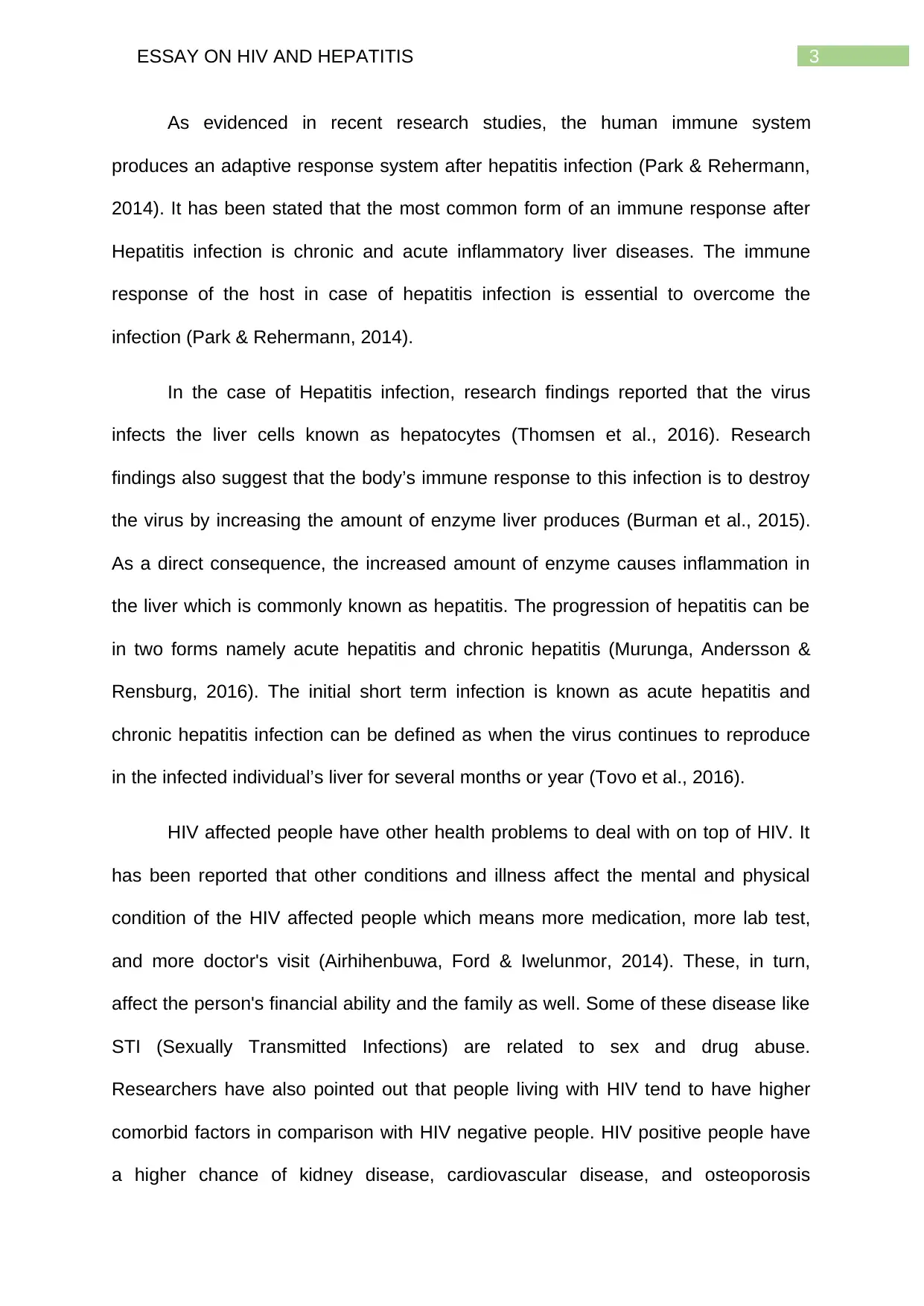
3ESSAY ON HIV AND HEPATITIS
As evidenced in recent research studies, the human immune system
produces an adaptive response system after hepatitis infection (Park & Rehermann,
2014). It has been stated that the most common form of an immune response after
Hepatitis infection is chronic and acute inflammatory liver diseases. The immune
response of the host in case of hepatitis infection is essential to overcome the
infection (Park & Rehermann, 2014).
In the case of Hepatitis infection, research findings reported that the virus
infects the liver cells known as hepatocytes (Thomsen et al., 2016). Research
findings also suggest that the body’s immune response to this infection is to destroy
the virus by increasing the amount of enzyme liver produces (Burman et al., 2015).
As a direct consequence, the increased amount of enzyme causes inflammation in
the liver which is commonly known as hepatitis. The progression of hepatitis can be
in two forms namely acute hepatitis and chronic hepatitis (Murunga, Andersson &
Rensburg, 2016). The initial short term infection is known as acute hepatitis and
chronic hepatitis infection can be defined as when the virus continues to reproduce
in the infected individual’s liver for several months or year (Tovo et al., 2016).
HIV affected people have other health problems to deal with on top of HIV. It
has been reported that other conditions and illness affect the mental and physical
condition of the HIV affected people which means more medication, more lab test,
and more doctor's visit (Airhihenbuwa, Ford & Iwelunmor, 2014). These, in turn,
affect the person's financial ability and the family as well. Some of these disease like
STI (Sexually Transmitted Infections) are related to sex and drug abuse.
Researchers have also pointed out that people living with HIV tend to have higher
comorbid factors in comparison with HIV negative people. HIV positive people have
a higher chance of kidney disease, cardiovascular disease, and osteoporosis
As evidenced in recent research studies, the human immune system
produces an adaptive response system after hepatitis infection (Park & Rehermann,
2014). It has been stated that the most common form of an immune response after
Hepatitis infection is chronic and acute inflammatory liver diseases. The immune
response of the host in case of hepatitis infection is essential to overcome the
infection (Park & Rehermann, 2014).
In the case of Hepatitis infection, research findings reported that the virus
infects the liver cells known as hepatocytes (Thomsen et al., 2016). Research
findings also suggest that the body’s immune response to this infection is to destroy
the virus by increasing the amount of enzyme liver produces (Burman et al., 2015).
As a direct consequence, the increased amount of enzyme causes inflammation in
the liver which is commonly known as hepatitis. The progression of hepatitis can be
in two forms namely acute hepatitis and chronic hepatitis (Murunga, Andersson &
Rensburg, 2016). The initial short term infection is known as acute hepatitis and
chronic hepatitis infection can be defined as when the virus continues to reproduce
in the infected individual’s liver for several months or year (Tovo et al., 2016).
HIV affected people have other health problems to deal with on top of HIV. It
has been reported that other conditions and illness affect the mental and physical
condition of the HIV affected people which means more medication, more lab test,
and more doctor's visit (Airhihenbuwa, Ford & Iwelunmor, 2014). These, in turn,
affect the person's financial ability and the family as well. Some of these disease like
STI (Sexually Transmitted Infections) are related to sex and drug abuse.
Researchers have also pointed out that people living with HIV tend to have higher
comorbid factors in comparison with HIV negative people. HIV positive people have
a higher chance of kidney disease, cardiovascular disease, and osteoporosis
Paraphrase This Document
Need a fresh take? Get an instant paraphrase of this document with our AI Paraphraser
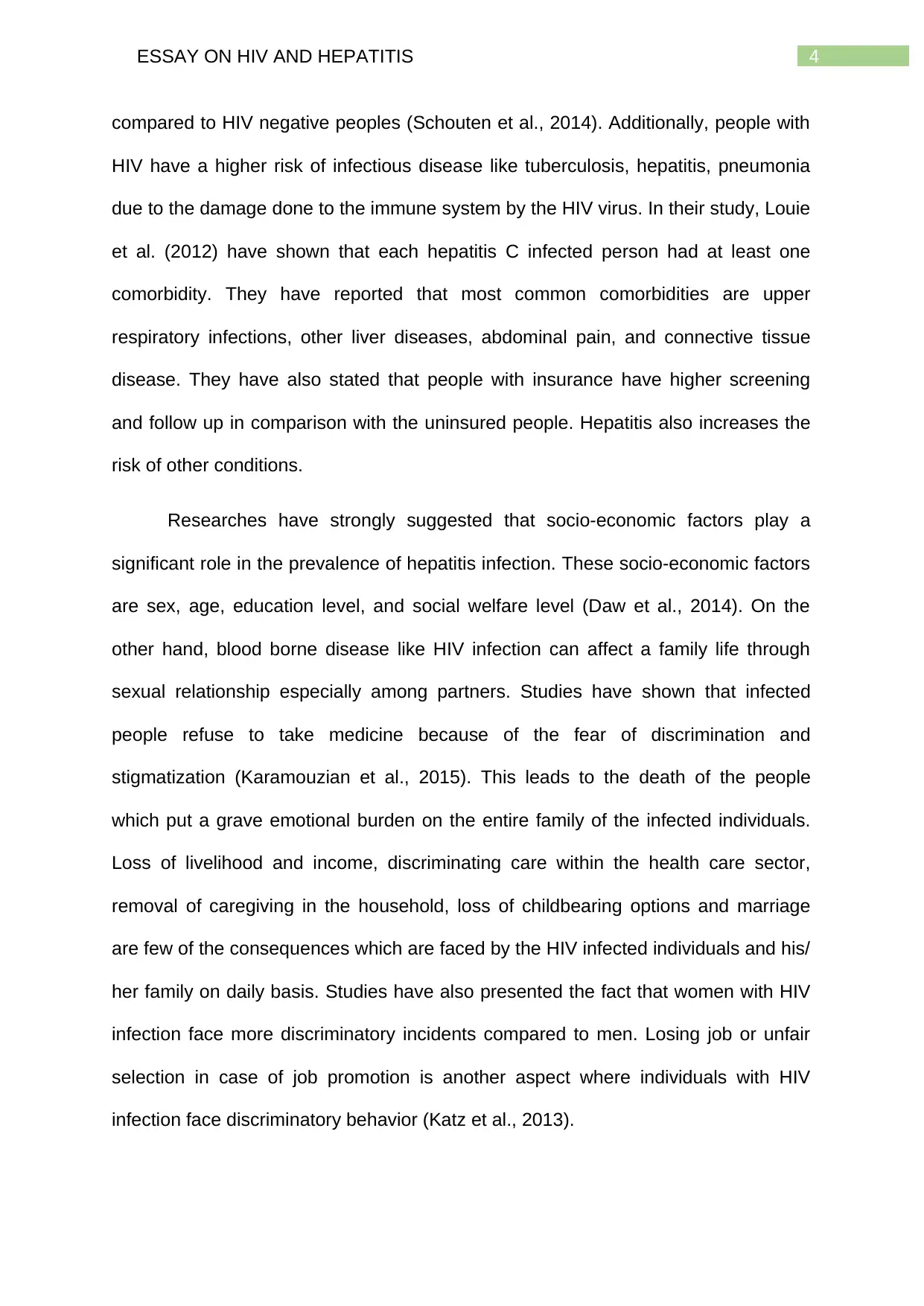
4ESSAY ON HIV AND HEPATITIS
compared to HIV negative peoples (Schouten et al., 2014). Additionally, people with
HIV have a higher risk of infectious disease like tuberculosis, hepatitis, pneumonia
due to the damage done to the immune system by the HIV virus. In their study, Louie
et al. (2012) have shown that each hepatitis C infected person had at least one
comorbidity. They have reported that most common comorbidities are upper
respiratory infections, other liver diseases, abdominal pain, and connective tissue
disease. They have also stated that people with insurance have higher screening
and follow up in comparison with the uninsured people. Hepatitis also increases the
risk of other conditions.
Researches have strongly suggested that socio-economic factors play a
significant role in the prevalence of hepatitis infection. These socio-economic factors
are sex, age, education level, and social welfare level (Daw et al., 2014). On the
other hand, blood borne disease like HIV infection can affect a family life through
sexual relationship especially among partners. Studies have shown that infected
people refuse to take medicine because of the fear of discrimination and
stigmatization (Karamouzian et al., 2015). This leads to the death of the people
which put a grave emotional burden on the entire family of the infected individuals.
Loss of livelihood and income, discriminating care within the health care sector,
removal of caregiving in the household, loss of childbearing options and marriage
are few of the consequences which are faced by the HIV infected individuals and his/
her family on daily basis. Studies have also presented the fact that women with HIV
infection face more discriminatory incidents compared to men. Losing job or unfair
selection in case of job promotion is another aspect where individuals with HIV
infection face discriminatory behavior (Katz et al., 2013).
compared to HIV negative peoples (Schouten et al., 2014). Additionally, people with
HIV have a higher risk of infectious disease like tuberculosis, hepatitis, pneumonia
due to the damage done to the immune system by the HIV virus. In their study, Louie
et al. (2012) have shown that each hepatitis C infected person had at least one
comorbidity. They have reported that most common comorbidities are upper
respiratory infections, other liver diseases, abdominal pain, and connective tissue
disease. They have also stated that people with insurance have higher screening
and follow up in comparison with the uninsured people. Hepatitis also increases the
risk of other conditions.
Researches have strongly suggested that socio-economic factors play a
significant role in the prevalence of hepatitis infection. These socio-economic factors
are sex, age, education level, and social welfare level (Daw et al., 2014). On the
other hand, blood borne disease like HIV infection can affect a family life through
sexual relationship especially among partners. Studies have shown that infected
people refuse to take medicine because of the fear of discrimination and
stigmatization (Karamouzian et al., 2015). This leads to the death of the people
which put a grave emotional burden on the entire family of the infected individuals.
Loss of livelihood and income, discriminating care within the health care sector,
removal of caregiving in the household, loss of childbearing options and marriage
are few of the consequences which are faced by the HIV infected individuals and his/
her family on daily basis. Studies have also presented the fact that women with HIV
infection face more discriminatory incidents compared to men. Losing job or unfair
selection in case of job promotion is another aspect where individuals with HIV
infection face discriminatory behavior (Katz et al., 2013).
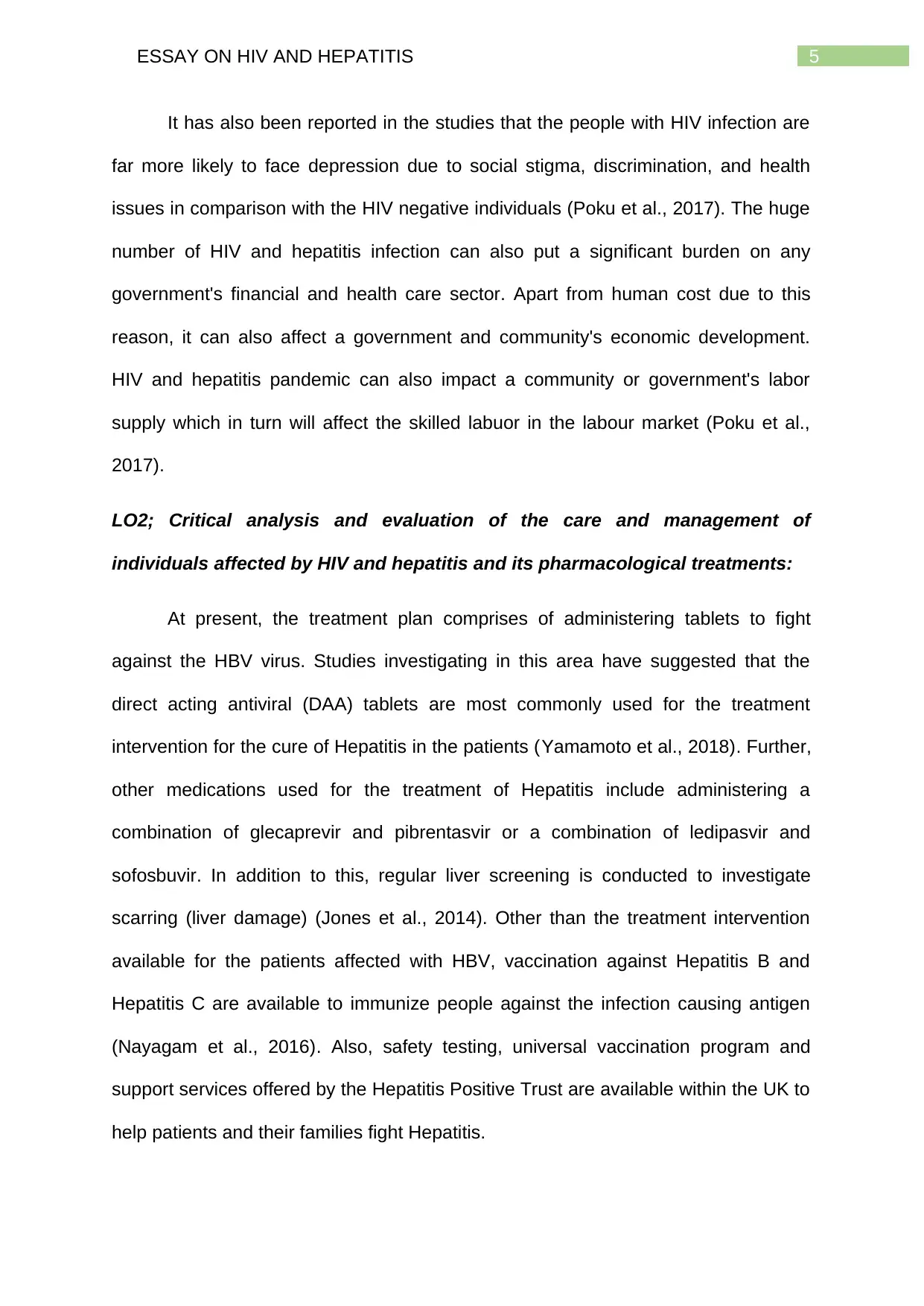
5ESSAY ON HIV AND HEPATITIS
It has also been reported in the studies that the people with HIV infection are
far more likely to face depression due to social stigma, discrimination, and health
issues in comparison with the HIV negative individuals (Poku et al., 2017). The huge
number of HIV and hepatitis infection can also put a significant burden on any
government's financial and health care sector. Apart from human cost due to this
reason, it can also affect a government and community's economic development.
HIV and hepatitis pandemic can also impact a community or government's labor
supply which in turn will affect the skilled labuor in the labour market (Poku et al.,
2017).
LO2; Critical analysis and evaluation of the care and management of
individuals affected by HIV and hepatitis and its pharmacological treatments:
At present, the treatment plan comprises of administering tablets to fight
against the HBV virus. Studies investigating in this area have suggested that the
direct acting antiviral (DAA) tablets are most commonly used for the treatment
intervention for the cure of Hepatitis in the patients (Yamamoto et al., 2018). Further,
other medications used for the treatment of Hepatitis include administering a
combination of glecaprevir and pibrentasvir or a combination of ledipasvir and
sofosbuvir. In addition to this, regular liver screening is conducted to investigate
scarring (liver damage) (Jones et al., 2014). Other than the treatment intervention
available for the patients affected with HBV, vaccination against Hepatitis B and
Hepatitis C are available to immunize people against the infection causing antigen
(Nayagam et al., 2016). Also, safety testing, universal vaccination program and
support services offered by the Hepatitis Positive Trust are available within the UK to
help patients and their families fight Hepatitis.
It has also been reported in the studies that the people with HIV infection are
far more likely to face depression due to social stigma, discrimination, and health
issues in comparison with the HIV negative individuals (Poku et al., 2017). The huge
number of HIV and hepatitis infection can also put a significant burden on any
government's financial and health care sector. Apart from human cost due to this
reason, it can also affect a government and community's economic development.
HIV and hepatitis pandemic can also impact a community or government's labor
supply which in turn will affect the skilled labuor in the labour market (Poku et al.,
2017).
LO2; Critical analysis and evaluation of the care and management of
individuals affected by HIV and hepatitis and its pharmacological treatments:
At present, the treatment plan comprises of administering tablets to fight
against the HBV virus. Studies investigating in this area have suggested that the
direct acting antiviral (DAA) tablets are most commonly used for the treatment
intervention for the cure of Hepatitis in the patients (Yamamoto et al., 2018). Further,
other medications used for the treatment of Hepatitis include administering a
combination of glecaprevir and pibrentasvir or a combination of ledipasvir and
sofosbuvir. In addition to this, regular liver screening is conducted to investigate
scarring (liver damage) (Jones et al., 2014). Other than the treatment intervention
available for the patients affected with HBV, vaccination against Hepatitis B and
Hepatitis C are available to immunize people against the infection causing antigen
(Nayagam et al., 2016). Also, safety testing, universal vaccination program and
support services offered by the Hepatitis Positive Trust are available within the UK to
help patients and their families fight Hepatitis.
⊘ This is a preview!⊘
Do you want full access?
Subscribe today to unlock all pages.

Trusted by 1+ million students worldwide
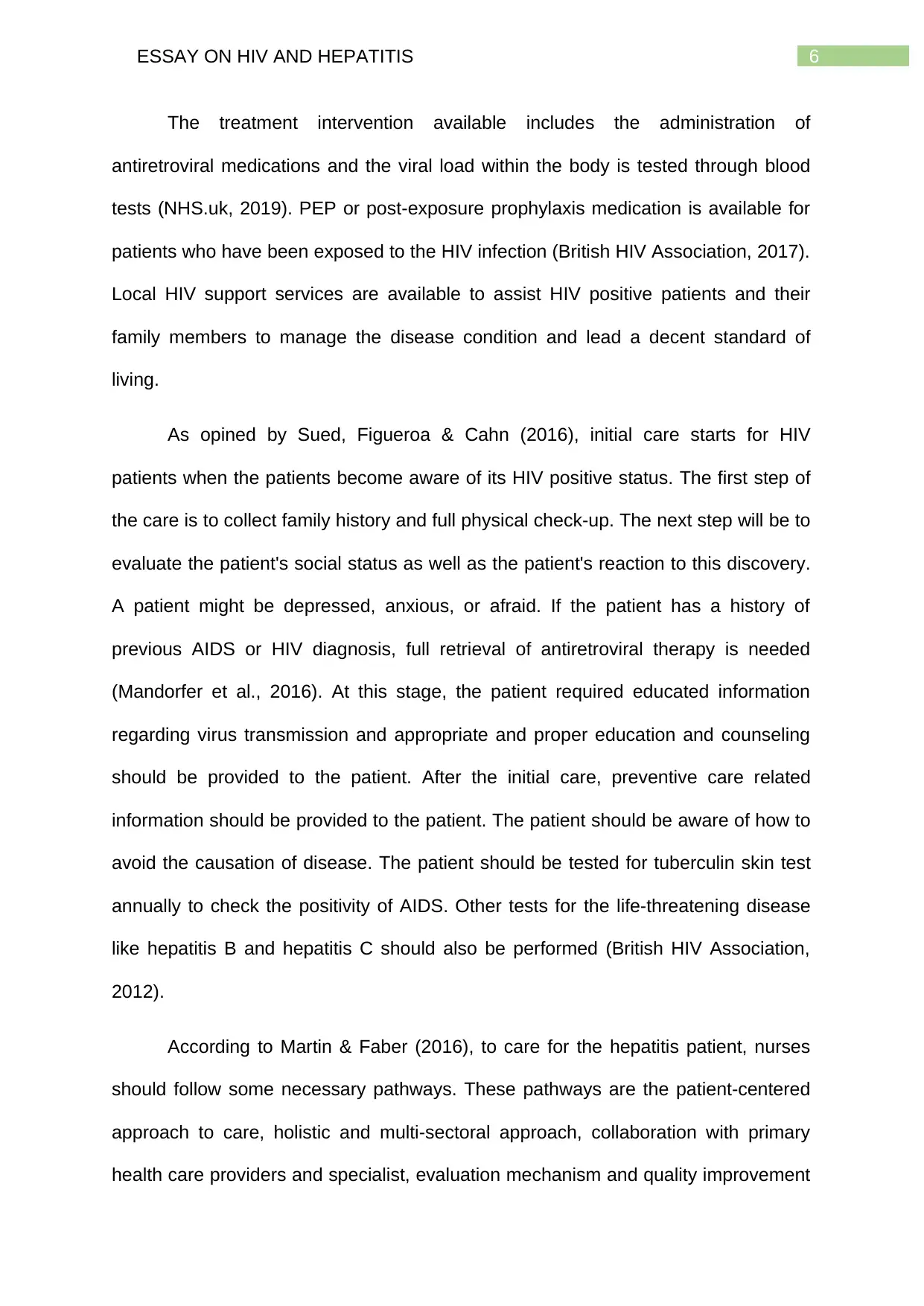
6ESSAY ON HIV AND HEPATITIS
The treatment intervention available includes the administration of
antiretroviral medications and the viral load within the body is tested through blood
tests (NHS.uk, 2019). PEP or post-exposure prophylaxis medication is available for
patients who have been exposed to the HIV infection (British HIV Association, 2017).
Local HIV support services are available to assist HIV positive patients and their
family members to manage the disease condition and lead a decent standard of
living.
As opined by Sued, Figueroa & Cahn (2016), initial care starts for HIV
patients when the patients become aware of its HIV positive status. The first step of
the care is to collect family history and full physical check-up. The next step will be to
evaluate the patient's social status as well as the patient's reaction to this discovery.
A patient might be depressed, anxious, or afraid. If the patient has a history of
previous AIDS or HIV diagnosis, full retrieval of antiretroviral therapy is needed
(Mandorfer et al., 2016). At this stage, the patient required educated information
regarding virus transmission and appropriate and proper education and counseling
should be provided to the patient. After the initial care, preventive care related
information should be provided to the patient. The patient should be aware of how to
avoid the causation of disease. The patient should be tested for tuberculin skin test
annually to check the positivity of AIDS. Other tests for the life-threatening disease
like hepatitis B and hepatitis C should also be performed (British HIV Association,
2012).
According to Martin & Faber (2016), to care for the hepatitis patient, nurses
should follow some necessary pathways. These pathways are the patient-centered
approach to care, holistic and multi-sectoral approach, collaboration with primary
health care providers and specialist, evaluation mechanism and quality improvement
The treatment intervention available includes the administration of
antiretroviral medications and the viral load within the body is tested through blood
tests (NHS.uk, 2019). PEP or post-exposure prophylaxis medication is available for
patients who have been exposed to the HIV infection (British HIV Association, 2017).
Local HIV support services are available to assist HIV positive patients and their
family members to manage the disease condition and lead a decent standard of
living.
As opined by Sued, Figueroa & Cahn (2016), initial care starts for HIV
patients when the patients become aware of its HIV positive status. The first step of
the care is to collect family history and full physical check-up. The next step will be to
evaluate the patient's social status as well as the patient's reaction to this discovery.
A patient might be depressed, anxious, or afraid. If the patient has a history of
previous AIDS or HIV diagnosis, full retrieval of antiretroviral therapy is needed
(Mandorfer et al., 2016). At this stage, the patient required educated information
regarding virus transmission and appropriate and proper education and counseling
should be provided to the patient. After the initial care, preventive care related
information should be provided to the patient. The patient should be aware of how to
avoid the causation of disease. The patient should be tested for tuberculin skin test
annually to check the positivity of AIDS. Other tests for the life-threatening disease
like hepatitis B and hepatitis C should also be performed (British HIV Association,
2012).
According to Martin & Faber (2016), to care for the hepatitis patient, nurses
should follow some necessary pathways. These pathways are the patient-centered
approach to care, holistic and multi-sectoral approach, collaboration with primary
health care providers and specialist, evaluation mechanism and quality improvement
Paraphrase This Document
Need a fresh take? Get an instant paraphrase of this document with our AI Paraphraser
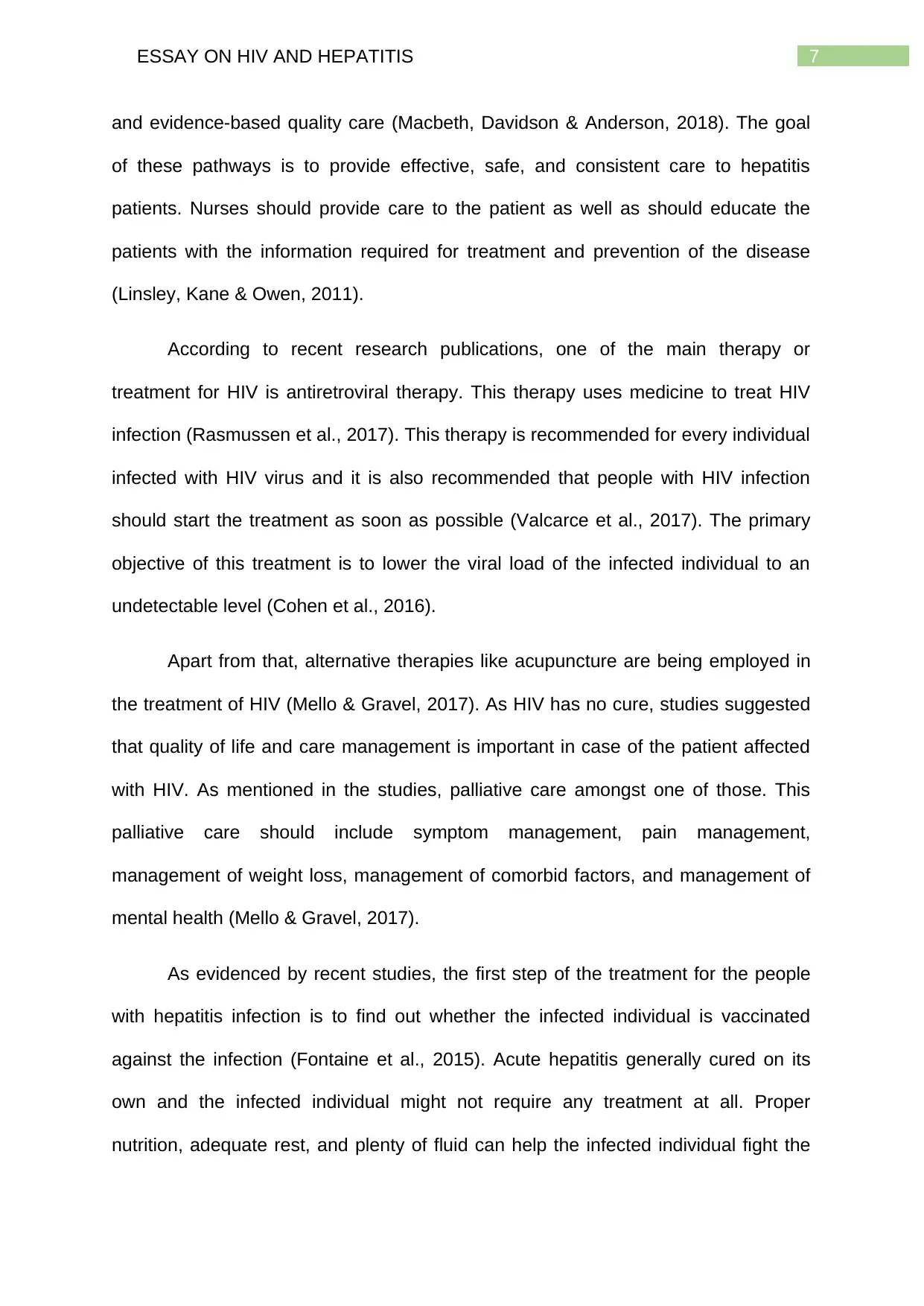
7ESSAY ON HIV AND HEPATITIS
and evidence-based quality care (Macbeth, Davidson & Anderson, 2018). The goal
of these pathways is to provide effective, safe, and consistent care to hepatitis
patients. Nurses should provide care to the patient as well as should educate the
patients with the information required for treatment and prevention of the disease
(Linsley, Kane & Owen, 2011).
According to recent research publications, one of the main therapy or
treatment for HIV is antiretroviral therapy. This therapy uses medicine to treat HIV
infection (Rasmussen et al., 2017). This therapy is recommended for every individual
infected with HIV virus and it is also recommended that people with HIV infection
should start the treatment as soon as possible (Valcarce et al., 2017). The primary
objective of this treatment is to lower the viral load of the infected individual to an
undetectable level (Cohen et al., 2016).
Apart from that, alternative therapies like acupuncture are being employed in
the treatment of HIV (Mello & Gravel, 2017). As HIV has no cure, studies suggested
that quality of life and care management is important in case of the patient affected
with HIV. As mentioned in the studies, palliative care amongst one of those. This
palliative care should include symptom management, pain management,
management of weight loss, management of comorbid factors, and management of
mental health (Mello & Gravel, 2017).
As evidenced by recent studies, the first step of the treatment for the people
with hepatitis infection is to find out whether the infected individual is vaccinated
against the infection (Fontaine et al., 2015). Acute hepatitis generally cured on its
own and the infected individual might not require any treatment at all. Proper
nutrition, adequate rest, and plenty of fluid can help the infected individual fight the
and evidence-based quality care (Macbeth, Davidson & Anderson, 2018). The goal
of these pathways is to provide effective, safe, and consistent care to hepatitis
patients. Nurses should provide care to the patient as well as should educate the
patients with the information required for treatment and prevention of the disease
(Linsley, Kane & Owen, 2011).
According to recent research publications, one of the main therapy or
treatment for HIV is antiretroviral therapy. This therapy uses medicine to treat HIV
infection (Rasmussen et al., 2017). This therapy is recommended for every individual
infected with HIV virus and it is also recommended that people with HIV infection
should start the treatment as soon as possible (Valcarce et al., 2017). The primary
objective of this treatment is to lower the viral load of the infected individual to an
undetectable level (Cohen et al., 2016).
Apart from that, alternative therapies like acupuncture are being employed in
the treatment of HIV (Mello & Gravel, 2017). As HIV has no cure, studies suggested
that quality of life and care management is important in case of the patient affected
with HIV. As mentioned in the studies, palliative care amongst one of those. This
palliative care should include symptom management, pain management,
management of weight loss, management of comorbid factors, and management of
mental health (Mello & Gravel, 2017).
As evidenced by recent studies, the first step of the treatment for the people
with hepatitis infection is to find out whether the infected individual is vaccinated
against the infection (Fontaine et al., 2015). Acute hepatitis generally cured on its
own and the infected individual might not require any treatment at all. Proper
nutrition, adequate rest, and plenty of fluid can help the infected individual fight the
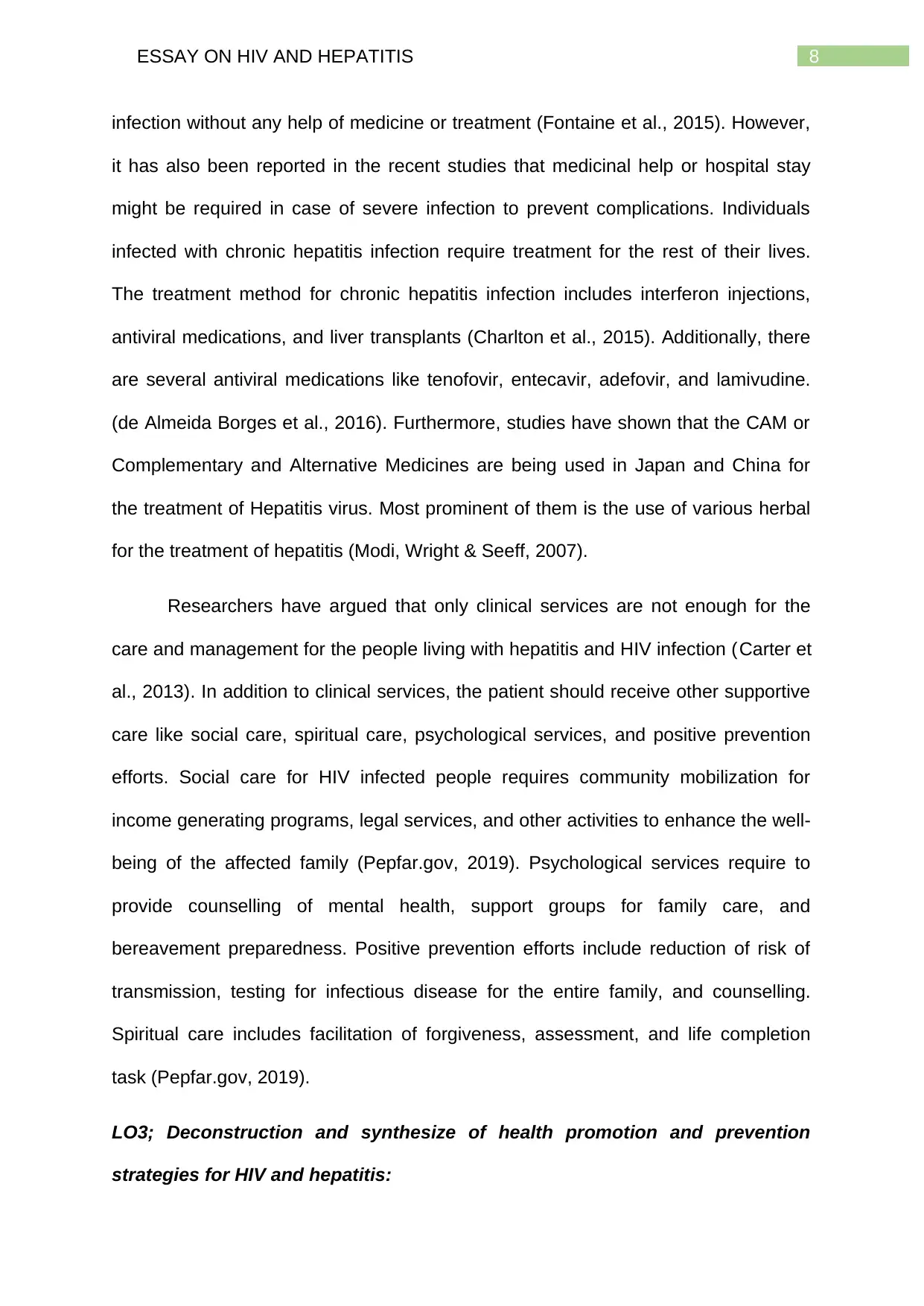
8ESSAY ON HIV AND HEPATITIS
infection without any help of medicine or treatment (Fontaine et al., 2015). However,
it has also been reported in the recent studies that medicinal help or hospital stay
might be required in case of severe infection to prevent complications. Individuals
infected with chronic hepatitis infection require treatment for the rest of their lives.
The treatment method for chronic hepatitis infection includes interferon injections,
antiviral medications, and liver transplants (Charlton et al., 2015). Additionally, there
are several antiviral medications like tenofovir, entecavir, adefovir, and lamivudine.
(de Almeida Borges et al., 2016). Furthermore, studies have shown that the CAM or
Complementary and Alternative Medicines are being used in Japan and China for
the treatment of Hepatitis virus. Most prominent of them is the use of various herbal
for the treatment of hepatitis (Modi, Wright & Seeff, 2007).
Researchers have argued that only clinical services are not enough for the
care and management for the people living with hepatitis and HIV infection (Carter et
al., 2013). In addition to clinical services, the patient should receive other supportive
care like social care, spiritual care, psychological services, and positive prevention
efforts. Social care for HIV infected people requires community mobilization for
income generating programs, legal services, and other activities to enhance the well-
being of the affected family (Pepfar.gov, 2019). Psychological services require to
provide counselling of mental health, support groups for family care, and
bereavement preparedness. Positive prevention efforts include reduction of risk of
transmission, testing for infectious disease for the entire family, and counselling.
Spiritual care includes facilitation of forgiveness, assessment, and life completion
task (Pepfar.gov, 2019).
LO3; Deconstruction and synthesize of health promotion and prevention
strategies for HIV and hepatitis:
infection without any help of medicine or treatment (Fontaine et al., 2015). However,
it has also been reported in the recent studies that medicinal help or hospital stay
might be required in case of severe infection to prevent complications. Individuals
infected with chronic hepatitis infection require treatment for the rest of their lives.
The treatment method for chronic hepatitis infection includes interferon injections,
antiviral medications, and liver transplants (Charlton et al., 2015). Additionally, there
are several antiviral medications like tenofovir, entecavir, adefovir, and lamivudine.
(de Almeida Borges et al., 2016). Furthermore, studies have shown that the CAM or
Complementary and Alternative Medicines are being used in Japan and China for
the treatment of Hepatitis virus. Most prominent of them is the use of various herbal
for the treatment of hepatitis (Modi, Wright & Seeff, 2007).
Researchers have argued that only clinical services are not enough for the
care and management for the people living with hepatitis and HIV infection (Carter et
al., 2013). In addition to clinical services, the patient should receive other supportive
care like social care, spiritual care, psychological services, and positive prevention
efforts. Social care for HIV infected people requires community mobilization for
income generating programs, legal services, and other activities to enhance the well-
being of the affected family (Pepfar.gov, 2019). Psychological services require to
provide counselling of mental health, support groups for family care, and
bereavement preparedness. Positive prevention efforts include reduction of risk of
transmission, testing for infectious disease for the entire family, and counselling.
Spiritual care includes facilitation of forgiveness, assessment, and life completion
task (Pepfar.gov, 2019).
LO3; Deconstruction and synthesize of health promotion and prevention
strategies for HIV and hepatitis:
⊘ This is a preview!⊘
Do you want full access?
Subscribe today to unlock all pages.

Trusted by 1+ million students worldwide
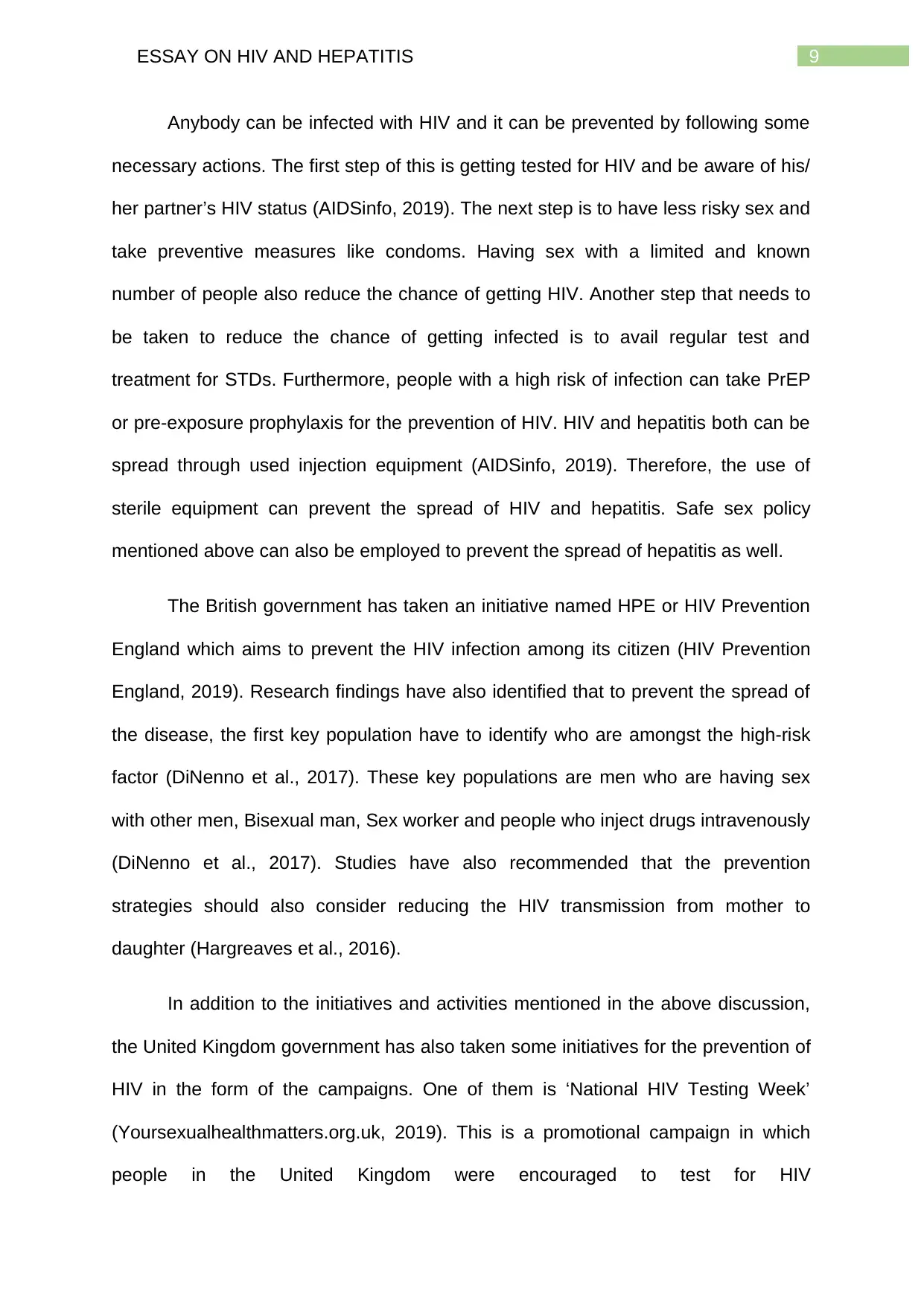
9ESSAY ON HIV AND HEPATITIS
Anybody can be infected with HIV and it can be prevented by following some
necessary actions. The first step of this is getting tested for HIV and be aware of his/
her partner’s HIV status (AIDSinfo, 2019). The next step is to have less risky sex and
take preventive measures like condoms. Having sex with a limited and known
number of people also reduce the chance of getting HIV. Another step that needs to
be taken to reduce the chance of getting infected is to avail regular test and
treatment for STDs. Furthermore, people with a high risk of infection can take PrEP
or pre-exposure prophylaxis for the prevention of HIV. HIV and hepatitis both can be
spread through used injection equipment (AIDSinfo, 2019). Therefore, the use of
sterile equipment can prevent the spread of HIV and hepatitis. Safe sex policy
mentioned above can also be employed to prevent the spread of hepatitis as well.
The British government has taken an initiative named HPE or HIV Prevention
England which aims to prevent the HIV infection among its citizen (HIV Prevention
England, 2019). Research findings have also identified that to prevent the spread of
the disease, the first key population have to identify who are amongst the high-risk
factor (DiNenno et al., 2017). These key populations are men who are having sex
with other men, Bisexual man, Sex worker and people who inject drugs intravenously
(DiNenno et al., 2017). Studies have also recommended that the prevention
strategies should also consider reducing the HIV transmission from mother to
daughter (Hargreaves et al., 2016).
In addition to the initiatives and activities mentioned in the above discussion,
the United Kingdom government has also taken some initiatives for the prevention of
HIV in the form of the campaigns. One of them is ‘National HIV Testing Week’
(Yoursexualhealthmatters.org.uk, 2019). This is a promotional campaign in which
people in the United Kingdom were encouraged to test for HIV
Anybody can be infected with HIV and it can be prevented by following some
necessary actions. The first step of this is getting tested for HIV and be aware of his/
her partner’s HIV status (AIDSinfo, 2019). The next step is to have less risky sex and
take preventive measures like condoms. Having sex with a limited and known
number of people also reduce the chance of getting HIV. Another step that needs to
be taken to reduce the chance of getting infected is to avail regular test and
treatment for STDs. Furthermore, people with a high risk of infection can take PrEP
or pre-exposure prophylaxis for the prevention of HIV. HIV and hepatitis both can be
spread through used injection equipment (AIDSinfo, 2019). Therefore, the use of
sterile equipment can prevent the spread of HIV and hepatitis. Safe sex policy
mentioned above can also be employed to prevent the spread of hepatitis as well.
The British government has taken an initiative named HPE or HIV Prevention
England which aims to prevent the HIV infection among its citizen (HIV Prevention
England, 2019). Research findings have also identified that to prevent the spread of
the disease, the first key population have to identify who are amongst the high-risk
factor (DiNenno et al., 2017). These key populations are men who are having sex
with other men, Bisexual man, Sex worker and people who inject drugs intravenously
(DiNenno et al., 2017). Studies have also recommended that the prevention
strategies should also consider reducing the HIV transmission from mother to
daughter (Hargreaves et al., 2016).
In addition to the initiatives and activities mentioned in the above discussion,
the United Kingdom government has also taken some initiatives for the prevention of
HIV in the form of the campaigns. One of them is ‘National HIV Testing Week’
(Yoursexualhealthmatters.org.uk, 2019). This is a promotional campaign in which
people in the United Kingdom were encouraged to test for HIV
Paraphrase This Document
Need a fresh take? Get an instant paraphrase of this document with our AI Paraphraser
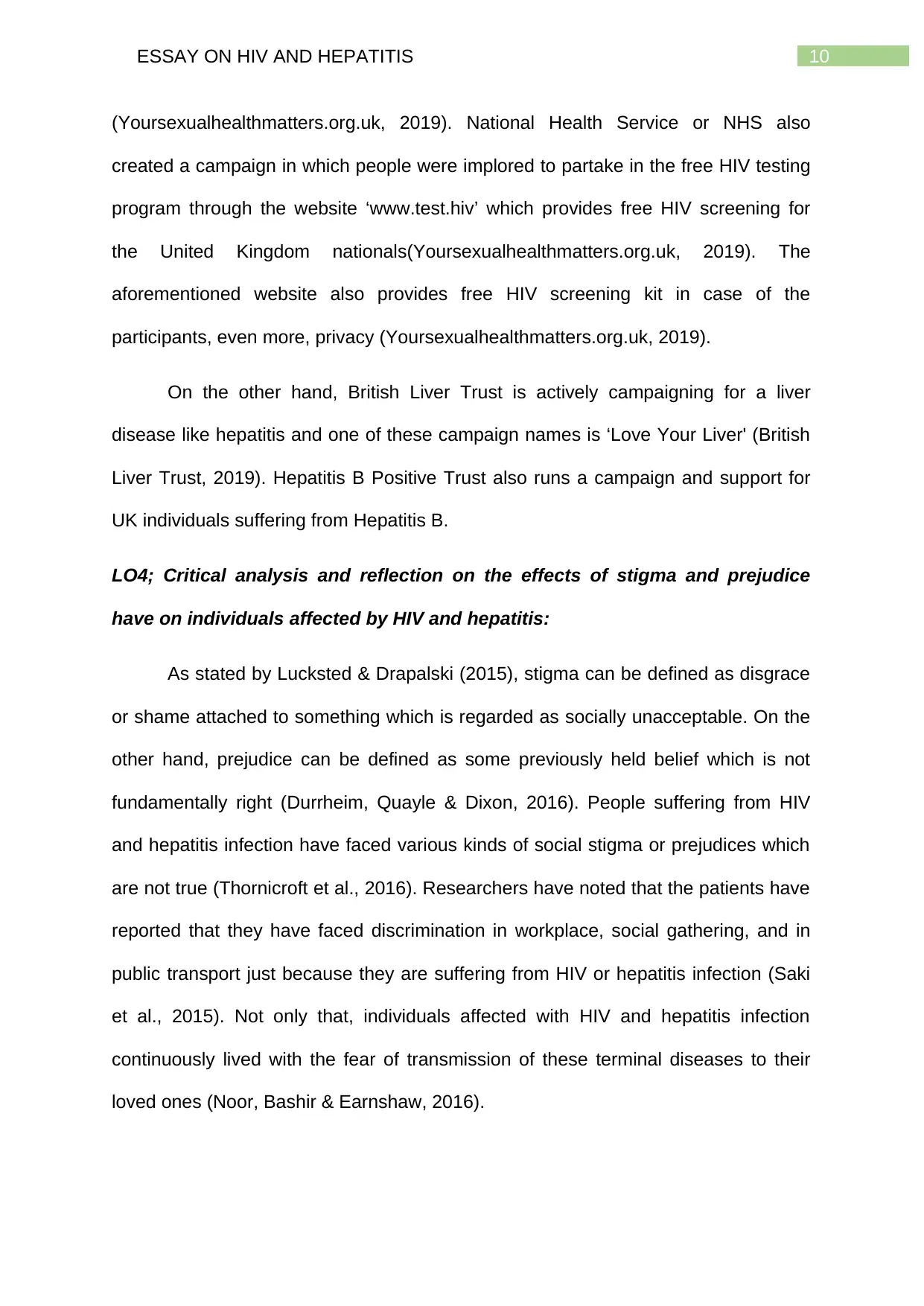
10ESSAY ON HIV AND HEPATITIS
(Yoursexualhealthmatters.org.uk, 2019). National Health Service or NHS also
created a campaign in which people were implored to partake in the free HIV testing
program through the website ‘www.test.hiv’ which provides free HIV screening for
the United Kingdom nationals(Yoursexualhealthmatters.org.uk, 2019). The
aforementioned website also provides free HIV screening kit in case of the
participants, even more, privacy (Yoursexualhealthmatters.org.uk, 2019).
On the other hand, British Liver Trust is actively campaigning for a liver
disease like hepatitis and one of these campaign names is ‘Love Your Liver' (British
Liver Trust, 2019). Hepatitis B Positive Trust also runs a campaign and support for
UK individuals suffering from Hepatitis B.
LO4; Critical analysis and reflection on the effects of stigma and prejudice
have on individuals affected by HIV and hepatitis:
As stated by Lucksted & Drapalski (2015), stigma can be defined as disgrace
or shame attached to something which is regarded as socially unacceptable. On the
other hand, prejudice can be defined as some previously held belief which is not
fundamentally right (Durrheim, Quayle & Dixon, 2016). People suffering from HIV
and hepatitis infection have faced various kinds of social stigma or prejudices which
are not true (Thornicroft et al., 2016). Researchers have noted that the patients have
reported that they have faced discrimination in workplace, social gathering, and in
public transport just because they are suffering from HIV or hepatitis infection (Saki
et al., 2015). Not only that, individuals affected with HIV and hepatitis infection
continuously lived with the fear of transmission of these terminal diseases to their
loved ones (Noor, Bashir & Earnshaw, 2016).
(Yoursexualhealthmatters.org.uk, 2019). National Health Service or NHS also
created a campaign in which people were implored to partake in the free HIV testing
program through the website ‘www.test.hiv’ which provides free HIV screening for
the United Kingdom nationals(Yoursexualhealthmatters.org.uk, 2019). The
aforementioned website also provides free HIV screening kit in case of the
participants, even more, privacy (Yoursexualhealthmatters.org.uk, 2019).
On the other hand, British Liver Trust is actively campaigning for a liver
disease like hepatitis and one of these campaign names is ‘Love Your Liver' (British
Liver Trust, 2019). Hepatitis B Positive Trust also runs a campaign and support for
UK individuals suffering from Hepatitis B.
LO4; Critical analysis and reflection on the effects of stigma and prejudice
have on individuals affected by HIV and hepatitis:
As stated by Lucksted & Drapalski (2015), stigma can be defined as disgrace
or shame attached to something which is regarded as socially unacceptable. On the
other hand, prejudice can be defined as some previously held belief which is not
fundamentally right (Durrheim, Quayle & Dixon, 2016). People suffering from HIV
and hepatitis infection have faced various kinds of social stigma or prejudices which
are not true (Thornicroft et al., 2016). Researchers have noted that the patients have
reported that they have faced discrimination in workplace, social gathering, and in
public transport just because they are suffering from HIV or hepatitis infection (Saki
et al., 2015). Not only that, individuals affected with HIV and hepatitis infection
continuously lived with the fear of transmission of these terminal diseases to their
loved ones (Noor, Bashir & Earnshaw, 2016).
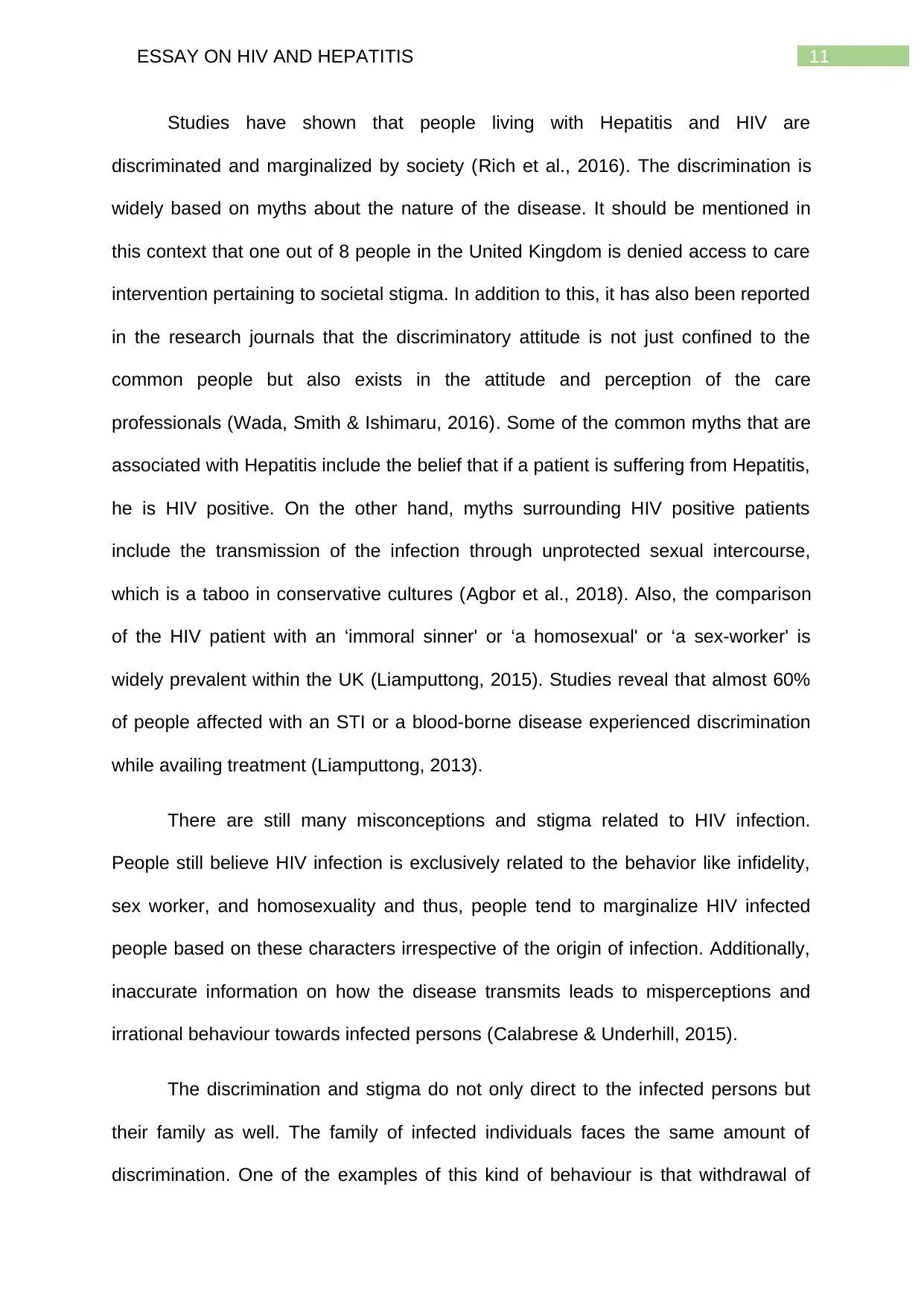
11ESSAY ON HIV AND HEPATITIS
Studies have shown that people living with Hepatitis and HIV are
discriminated and marginalized by society (Rich et al., 2016). The discrimination is
widely based on myths about the nature of the disease. It should be mentioned in
this context that one out of 8 people in the United Kingdom is denied access to care
intervention pertaining to societal stigma. In addition to this, it has also been reported
in the research journals that the discriminatory attitude is not just confined to the
common people but also exists in the attitude and perception of the care
professionals (Wada, Smith & Ishimaru, 2016). Some of the common myths that are
associated with Hepatitis include the belief that if a patient is suffering from Hepatitis,
he is HIV positive. On the other hand, myths surrounding HIV positive patients
include the transmission of the infection through unprotected sexual intercourse,
which is a taboo in conservative cultures (Agbor et al., 2018). Also, the comparison
of the HIV patient with an ‘immoral sinner' or ‘a homosexual' or ‘a sex-worker' is
widely prevalent within the UK (Liamputtong, 2015). Studies reveal that almost 60%
of people affected with an STI or a blood-borne disease experienced discrimination
while availing treatment (Liamputtong, 2013).
There are still many misconceptions and stigma related to HIV infection.
People still believe HIV infection is exclusively related to the behavior like infidelity,
sex worker, and homosexuality and thus, people tend to marginalize HIV infected
people based on these characters irrespective of the origin of infection. Additionally,
inaccurate information on how the disease transmits leads to misperceptions and
irrational behaviour towards infected persons (Calabrese & Underhill, 2015).
The discrimination and stigma do not only direct to the infected persons but
their family as well. The family of infected individuals faces the same amount of
discrimination. One of the examples of this kind of behaviour is that withdrawal of
Studies have shown that people living with Hepatitis and HIV are
discriminated and marginalized by society (Rich et al., 2016). The discrimination is
widely based on myths about the nature of the disease. It should be mentioned in
this context that one out of 8 people in the United Kingdom is denied access to care
intervention pertaining to societal stigma. In addition to this, it has also been reported
in the research journals that the discriminatory attitude is not just confined to the
common people but also exists in the attitude and perception of the care
professionals (Wada, Smith & Ishimaru, 2016). Some of the common myths that are
associated with Hepatitis include the belief that if a patient is suffering from Hepatitis,
he is HIV positive. On the other hand, myths surrounding HIV positive patients
include the transmission of the infection through unprotected sexual intercourse,
which is a taboo in conservative cultures (Agbor et al., 2018). Also, the comparison
of the HIV patient with an ‘immoral sinner' or ‘a homosexual' or ‘a sex-worker' is
widely prevalent within the UK (Liamputtong, 2015). Studies reveal that almost 60%
of people affected with an STI or a blood-borne disease experienced discrimination
while availing treatment (Liamputtong, 2013).
There are still many misconceptions and stigma related to HIV infection.
People still believe HIV infection is exclusively related to the behavior like infidelity,
sex worker, and homosexuality and thus, people tend to marginalize HIV infected
people based on these characters irrespective of the origin of infection. Additionally,
inaccurate information on how the disease transmits leads to misperceptions and
irrational behaviour towards infected persons (Calabrese & Underhill, 2015).
The discrimination and stigma do not only direct to the infected persons but
their family as well. The family of infected individuals faces the same amount of
discrimination. One of the examples of this kind of behaviour is that withdrawal of
⊘ This is a preview!⊘
Do you want full access?
Subscribe today to unlock all pages.

Trusted by 1+ million students worldwide
1 out of 27
Related Documents
Your All-in-One AI-Powered Toolkit for Academic Success.
+13062052269
info@desklib.com
Available 24*7 on WhatsApp / Email
![[object Object]](/_next/static/media/star-bottom.7253800d.svg)
Unlock your academic potential
Copyright © 2020–2025 A2Z Services. All Rights Reserved. Developed and managed by ZUCOL.





